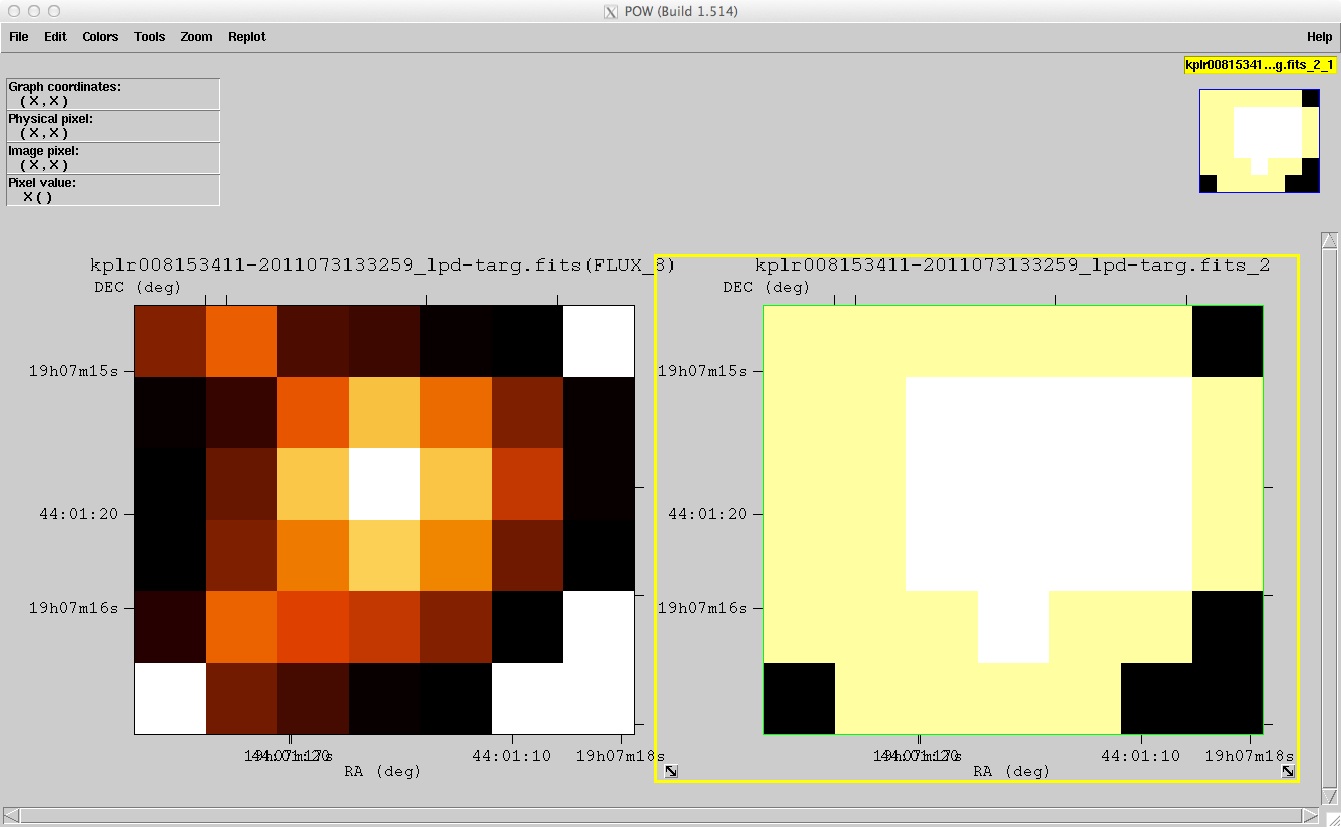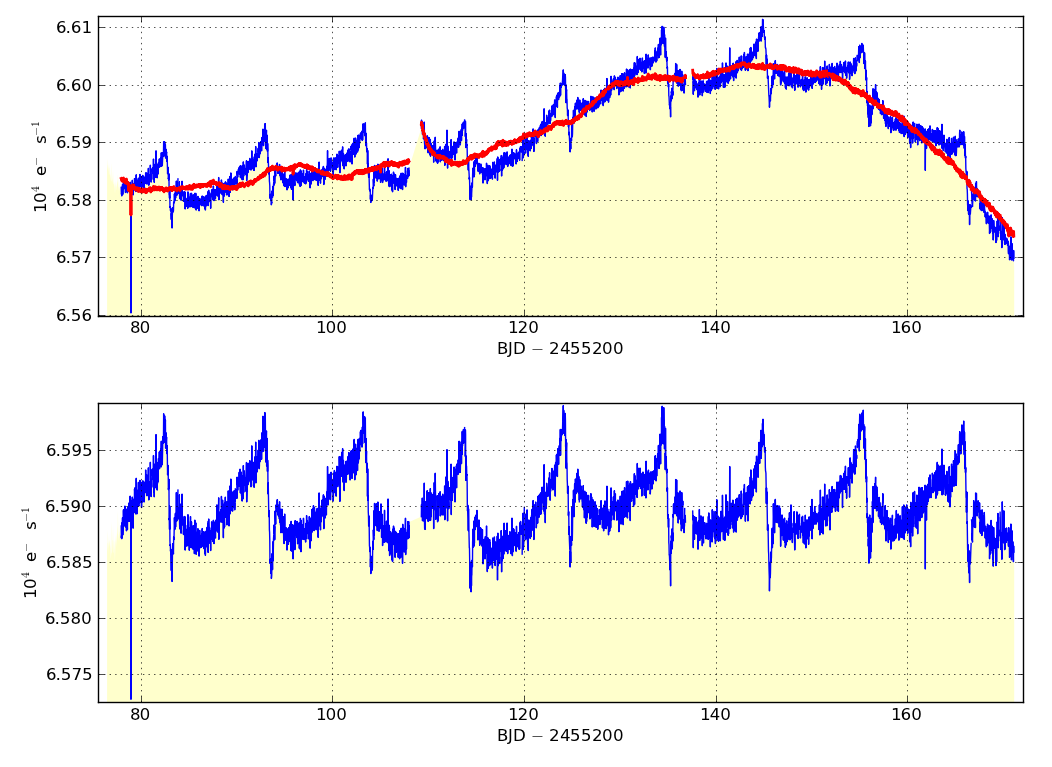|
|
|
||

| |||
| Kepler Data Products | |||
|
FULL-FRAME IMAGES (FFIs) The Kepler detector is a photometer with an array of 42 CCDs. The Kepler field of view spans 115.6 square degrees over 95 million detector pixels, with a 3.98 x 3.98 arcsec pixels and 3.1-7.5 arcsec FWHM imaging point spread function. The Kepler field contains 10 million stars brighter than the confusion limit of 20-21 mag. The field of view and pixel scale were designed to maximize the number of resolvable stars brighter than $Kp = 15. Science data downloads occur approximately once per month when Kepler must leave the field temporarily to point its high-gain antenna towards Earth. Immediately before each data download, a 29.4 min image of the entire field of view is collected and transmitted. These are the FFIs. FFIs are delivered to the public as soon as calibration is complete and they can be downloaded from a dedicated data retrieval page at MAST. Potential science uses are:
FFI data format is defined in section 2.3.3 of the Kepler Archive Manual. Resources for inspecting and analyzing the FFIs are provided here. A quick tour of an FFI file is here.

Figure 1: A Kepler Full Frame Image. The field of view is 115.6 square degrees. The field contains on order 10 million stars down to the confusion limit of Kp = 20-21. TARGET PIXEL FILES (TPFs) The Kepler camera takes one exposure every 6.5s. Exposures are summed onboard and stored at either 1765.5 s (29.4 min) cadence or 58.89 s cadence. At these data collection cadences, the Solid State Recorder onboard the spacecraft can store only 5.4 million of the 95 million pixels available. The pixels collected are chosen strategically to provide postage stamp images centered on the positions of Kepler targets. The size of a postage stamp increases with target brightness and the average yield is 166,000 targets per month. A critical concept for understanding artifact issues in Kepler light curves is that in order to maximize the target yield, postage stamp sizes and shapes are chosen to maximize the signal-to-noise on the 3-12 hour timescales of exoplanet transits. Postage stamp pixels are chosen by a calculation that combines the photometry and astrometry within the Kepler Input Catalog and an analytical model for the detector and optics. Any variation in the position of the target within the postage stamp or the focus of the telescope will result in a redistribution of flux within the postage stamp pixels. The target pixel files are the rawest form of target-specific data available from the Kepler archive. Each row in the TPF table contains timestamps, photometric measurements, astrometric measurements and data quality flags. Potential science uses are:
The TPF data format is defined in section 2.3.2 of the Kepler Archive Manual. Resources for inspecting and analyzing the TPFs are provided here. TPFs are delivered to the public on a 3 month schedule. Long cadence TPFs contain 3-month baseline time series. Short cadence data contain 1-month baseline time series. TPFs can be downloaded from a dedicated data retrieval page at MAST. A cursory tour of an TPF file is here.

Figure 2: Typical images stored within a TPF. The left-hand image is stored in a time-tagged data table and contains calibrated, background-subtracted and cosmic ray removed pixel fluxes for one specific timestamp. The right-hand image contains a bitmap that describes the employment of each pixel in the Kepler pipeline. Black pixels were not collected by the spacecraft, yellow are collected but do not contribute to the photometry stored in the associated light curve file. White pixels are included in the photometric aperture that maximizes target signal-to-noise over nominal observations. LIGHT CURVE FILES The light curves are derived from the TPFs. There is a one-to-one correspondence between the files and time timestamps and quality flags within the two products are identical. The primary data within the light curve file is Simple Aperture Photometry - a summation of the calibrated pixels in the TPF. The nominal spacecraft pointing is good to typically 20 milli-arcsec over 6.5 hours but the high precision light curves still contain systematic noise. Noise (artifacts) manifest from thermally-driven focus changes, pointing derivatives and differential velocity aberration. Systematic artifacts within the light curves associated with these events and are the result of both time-dependent light losses falling out of the pixel apertures and time-dependent contamination of neighboring sources moving around within the pixel apertures. Within the pipeline, artifacts are mitigated for using a derivative of principle component analysis. The product of this analysis is provided within the light curve. It is the prerogative of archive users to determine whether the pipeline mitigation is suitable for their scientific goals or whether manual mitigation will be required. Light curve files also contain centroid measurements derived from the TPFs. Since many artifacts are the result of target motion within its pixel aperture, time-resolved correlations between target flux and motion provide useful diagnostics of systematic artifacts within the time series. Potential science uses are:
The light curve file format is defined in section 2.3.1 of the Kepler Archive Manual. Resources for inspecting and analyzing the light curves are provided here. Light curves are delivered to the public on a 3 month schedule. Light curves can be downloaded from a dedicated data retrieval page at MAST, the same location as the TPFs. A cursory tour of a light curve file is here. 
Figure 3: The long cadence Kepler light curve of a short-period, eclipsing binary star. The top window provides the Simple Aperture Photometry data in blue. The red line is the best fit to the data using Cotrending Basis Vectors derived from a Principle Component Analysis, containing estimates of short and long timescale systematic artifacts. The bottom window contains the same data after the artifact fit has been subtracted. Instruction to replicate this procedure can be found here. AUXILIARY DATA Auxiliary data is not collected directly by the spacecraft, but is derived from spacecraft data. The current auxiliary data comprises: Cotrending Basis Vectors (CBVs) Pixel Response Functions (PRFs)
Format and content of the PRF files is provided in section 2.3.5 of the Kepler Archive Manual. PRFs can be downloaded from here. The content of the PRF files can be inspected with FV or DS9. COLLATERAL DATA (files remain in development) Collateral data
is collected onboard for the purpose of calibrating science data. Collateral pixels
estimate the bias level, dark current and charge smear that results from shutter-less camera operation.
Pixels are collected around sparse fields in order to provide background measures. Each
CCD channel may have up to 4,500 background pixels. Currently collateral data is not available to users.
Questions concerning Kepler's science opportunities and open programs, public archive or community tools? Contact us via the email address. |